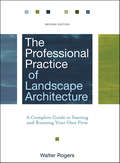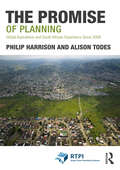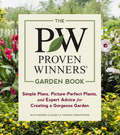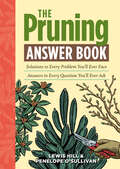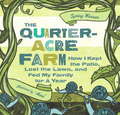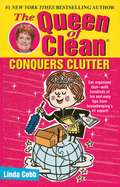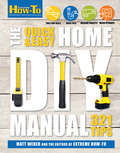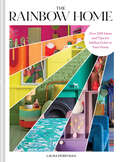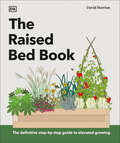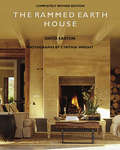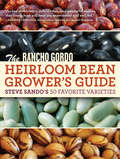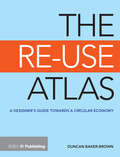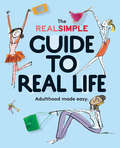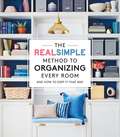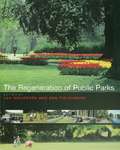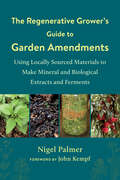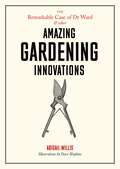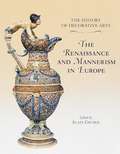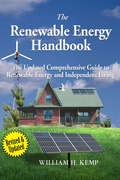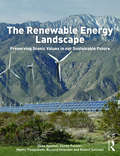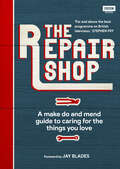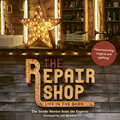- Table View
- List View
The Professional Practice of Landscape Architecture
by Walter Rogers Michaal DollinThe all-inclusive reference to starting and operating a landscape architecture firm The Professional Practice of Landscape Architecture, Second Edition is completely revised to keep up with the latest developments driving the day-to-day operation of a successful private-practice landscape architecture office. Whether helping a landscape architecture student identify a career track, providing direction on starting a new office, guiding an owner seeking to jumpstart a stagnant or fledgling business, or assisting a landscape architect-in-training study for the national Landscape Architecture Registration Exam (LARE), this single-source blueprint is the key to prospering in this dynamic field. This new edition features: Indispensible information for practicing landscape architects, including professional ethics, finances, office administration, marketing and promotion, and project management An updated look at government regulatory laws, federal tax administration, sustainable design, and LEED certification Strategies for using the Internet, computer software, and technology to market and manage a firm Examples of professional contract templates Case study profiles of landscape architecture firms Requirements for professional registration and criteria for taking the national exam This comprehensive and practical reference combines real-world experience with the highest professional standards to instruct the reader on business concepts. Expertly organized and easy to follow, The Professional Practice of Landscape Architecture, Second Edition continues to be the one source that landscape architects need to direct all facets of their practice.
The Promise of Planning: Global Aspirations and South African Experience Since 2008 (ISSN)
by Alison Todes Philip HarrisonThe Promise of Planning explores the experience of planning internationally since the global financial crisis, focusing on South Africa. The book is a response to a decade-plus in which state-led planning has re-emerged as a putative means for achieving developmental goals (as indicated in global initiatives such as the New Urban Agenda) and where planning in South Africa has consolidated in terms of its legal and policy basis. However, the return of planning is happening in an inauspicious context, with economic fragilities, technological shifts, political populism, institutional complexities, and more, threatening to upturn the "new promise of planning." The book provides a careful analytical account of planning in South Africa and how and why its promises have been difficult to achieve. Building on the authors’ previous book, Planning and Transformation, the book sheds light on planning as an increasingly complex and diverse governmental practice within a perpetually changing world. It can be used as a resource for planners who must make good on the new promise of planning while navigating the risks and threats of the contemporary world, as well as students and faculty interested in international planning debates and the South African case.
The Proven Winners Garden Book: Simple Plans, Picture-Perfect Plants, and Expert Advice for Creating a Gorgeous Garden
by Thomas Christopher Ruth Rogers ClausenGarden with the confidence of a winner! Proven Winners is America’s #1 plant brand. And now they are sharing their expert plant knowledge and creative design ideas in their first book, The Proven Winners Garden Book. This definitive guide starts with lessons on how to prepare a space, tips on choosing the right design, and a primer on buying the right plants. Twelve garden plans provide simple design ideas that will add curb appeal to your home garden. They include— A welcoming entrywayA butterfly and pollinator gardenA fragrant flower gardenA shady summertime retreatA deer-resistant garden There are an additional twenty-five container recipes that add color and pizzazz to gardens of all sizes—even on balconies and patios. The creative combinations include holiday themes, solutions for shade and other concerns, poolside ideas, and much more.
The Pruning Answer Book: Solutions to Every Problem You'll Ever Face; Answers to Every Question You'll Ever Ask (Answer Book Ser.)
by Lewis Hill Penelope O'SullivanWhen should you prune a blackberry bush? How much should you remove? What’s the difference between pinching and heading back? And how can you be sure that you aren’t harming your fragile blossoms? The Pruning Answer Book offers fresh insights to these relevant questions and scores of others. With clear instructions, detailed illustrations, and expert advice, you’ll have all the information you need to successfully prune flowering plants, fruit and nut trees, shrubs, brambles, evergreens, vines, groundcovers, and more.
The Quarter-Acre Farm: How I Kept the Patio, Lost the Lawn, and Fed My Family for a Year
by Jesse Pruet Spring WarrenWhen Spring Warren told her husband and two teenage boys that she wanted to grow 75 percent of all the food they consumed for one year-and that she wanted to do it in their yard-they told her she was crazy.She did it anyway.The Quarter-Acre Farm is Warren's account of deciding-despite all resistance-to take control of her family's food choices, get her hands dirty, and create a garden in her suburban yard. It's a story of bugs, worms, rot, and failure; of learning, replanting, harvesting, and eating. The road is long and riddled with mistakes, but by the end of her yearlong experiment, Warren's sons and husband have become her biggest fans-in fact, they're even eager to help harvest (and eat) the beautiful bounty she brings in.Full of tips and recipes to help anyone interested in growing and preparing at least a small part of their diet at home, The Quarter-Acre Farm is a warm, witty tale about family, food, and the incredible gratification that accompanies self-sufficiency.
The Queen of Clean Conquers Clutter
by Linda CobbWhen it comes to freeing your home of clutter (let's face it -- we all have it), The Queen of Clean really spells things out for you: Question Unpack Evaluate Eliminate Neaten up! It's a foolproof sorting system for even the most devoted packrat: Question the best possible use of a room, a closet, a drawer...Unpack all of your clutter to get a sense of what you have (and what you need to do with it)...Evaluate each and every item you own...Eliminate unwanted possessions without guilt or regrets...and Neaten up your belongings in their newly decluttered space. You'll find your home and your life organized like never before as you conquer clutter in the kitchen, bedroom, bathroom, attic, basement -- even the garage! The key, says the Queen, is to start small...and soon you'll be revved up and ready to straighten out every nook and cranny of your home. Her down-to-earth clutter-busting advice is built for speed; in a flash she sorts through and tidies up wallets, purses, drawers, closets, pantries, clothes, shoes, cosmetics, junk mail, linens, toys, books, videos, photos, collectibles, and much, much more! The Queen makes even the most dreaded organizing tasks a breeze with hundreds of easy and practical tips! Find out how good it feels to be a savvy manager of all that threatens to invade your orderly domain with these simple and effective strategies from America's #1 housekeeping expert, the Queen of Clean®.
The Quick & Easy Home DIY Manual: 321 Tips (Extreme How-To)
by Matt Weber The Editors of Extreme How-ToYour guide to tools, skills, quick fixes, weekend projects, and even major upgrades—packed with pro tips! Developing your do-it-yourself skills can save you significant money, make your dream home a reality—and be just plain fun. Whether it's simple projects like a busted pipe or clogged toilet, or bigger upgrades like a new floor or a deck, you&’ll find all the information you need to fix trouble spots, handle the unwelcome surprises of homeownership, and increase the value of your property. Learn about: Tools & Skills: How to build the ultimate DIY toolbox, outfit your workspace, and gain the pro skills that make even challenging projects surprisingly fun and easy. Quick Fixes: Quick yet durable fixes made easy. Fix a wonky toilet, ground an outlet, patch drywall, upgrade furniture frames and everything in between. Weekend Projects: Dozens of clever projects you thought would take you ages! Paint a room, redo a kitchen floor, spiff up cabinets, replace a toilet, patch a leaky roof. Big Jobs: Think you need a contractor? Think again. Create built-in shelving, install new flooring, construct a fence, build a deck, and more. With over three hundred handy tips, Matt Weber and the editors of Extreme How-To have you covered on all things home repair.
The Quilt Story
by Tony JohnstonA little girl named Abigail kept warm in the long, snowy winters with the help of a special quilt her mother made for her. When Abigail grew up, she packed the quilt away in an attic. Many years later, another little girl discovered the quilt, and felt the same comfort that Abigail once did.
The Rainbow Home: Over 200 Ideas and Tips for Adding Color to Your Home
by Laura PerrymanBring a rainbow of joy into your life with colorful home design and decor inspiration. The Rainbow Home features hundreds of easy DIYs and tips from leading home influencers for homeowners, renters, and anyone inspired by color.Many homes have color in them, but a rainbow home is one that uses color in a particular way. This could be a bright pop of surprising color, a room that pairs clashing colors, an intense use of pattern, or a clear rainbow effect. The overall feel is that the color is there to bring joy and to create a home that is extremely personal and unique. Like Pinterest at your fingertips, The Rainbow Home is the go-to reference book that makes it easy to define your own rainbow style and add color anywhere in your home. Divided by area (house front and doorways, hallways and stairs, living spaces, kitchens, eating and entertaining, sleeping spaces, bath and relaxation, home offices and craft rooms, storage solutions, and outdoor space), each chapter includes: Lots of clever DIYs, purchasable ideas, and photographic inspiration. An exploration of the three distinct “types” of rainbow colors: dopamine brights (intense bold and joyful colors), playful pastels (nostalgic and sweeter chromas), and uplifting neons (electric and punchy hues). A deeper dive into specific colors, breaking down the benefits of each, how to choose which shade is right for you, and a color pairing guide. Feature profiles on notable décor personalities, taking a peek into their colorful homes and sharing their advice, including such luminaries as Evie Kemp (@eviekemp), Stasia Buckle (@stasiabuckle), Maye Ruiz (@mayeruz), Lizzy Hingham (@lizzyhigham_interiorstyling), Shareen and Martin (@happyvillageinterior), and Sisi Alfred (@homewithsisi). A brilliant interior design coffee table book, The Rainbow Home is outstanding as a self-purchase for color enthusiasts, a housewarming present, or a handy guidebook for designers, stylists, color consultants, decorators, and creatives of all types.THOUSANDS OF DÉCOR IDEAS: Over 600 images with corresponding ideas and tips are included, so you’ll never run out of inspiration for your home. LEADING DÉCOR EXPERTS: This irresistibly aesthetic book features the dazzling homes and interiors of top #rainbowhome influencers who share their seasoned advice for making your home feel fun and colorful. RENTER-FRIENDLY TIPS & TRICKS: Much of the book’s advice is adaptable to a wide variety of spaces and budgets. Decorative paint and décor can be temporary or easily removed, so you don’t have to sacrifice your deposit to have a colorful home!Perfect for: Anyone interested in home décor and DIY ideas, maximalism, and design New apartment, house, or condo renters or owners looking for decorating inspiration Host or hostess gift-giving Fans of rainbows and colorful textiles, art, and collectibles
The Raised Bed Book: Get the Most from Your Raised Bed, Every Step of the Way
by DKWhether you want to garden at a more accessible height, improve soil fertility, nurture plants with needs, or simply enjoy a closer sensory experience, growing in raised beds will help you reach new heights in the garden.Raised beds are possible in any-size garden, even on balconies, but it needs expert advice to create the optimum growing conditions, achieve the most practical use of space tailored to your individual needs, and ensure longevity of the raised bed structure. Featuring clear diagrams, inspired planting plans, and step-by-step photography of beds built from scratch, this book will be the ultimate guide on your raised bed journey.In addition, 10 international gardeners, all sharing a love of raised beds, will explain their "take" and provide planting designs that will open your eyes to the variety of shapes, sizes, materials, and planting displays that are possible with a raised bed. From placing and designing, choosing materials, and growing media, to ongoing maintenance and how best to care for your plants, The Raised Bed Book is the final word on growing above ground.
The Rammed Earth House
by David Easton"The Rammed Earth House" is an eye-opening example of how the most dramatic innovations in home design and construction frequently have their origins in the distant past. By rediscovering the most ancient of all building materials-earth-forward-thinking homebuilders can now create structures that set new standards for beauty, durability, and efficient use of natural resources. Rammed earth construction is a step forward into a sustainable future, when homes will combine pleasing aesthetics and intense practicality with a powerful sense of place. Rammed earth homes are built entirely on-site, using basic elements-earth, water, and a little cement. The solid masonry walls permit design flexibility while providing year-round comfort and minimal use of energy. The builder and resident of a rammed earth house will experience the deep satisfaction of creating permanence in a world dominated by the disposable.
The Rancho Gordo Heirloom Bean Grower's Guide: Steve Sando's 50 Favorite Varieties
by Steve SandoSteve Sando founded Rancho Gordo with the simple idea that saving our New World foods is a critical pursuit, and his passion for heirloom beans has made his business a huge success. Sando’s beans are sought after by famous chefs like Thomas Keller (Vallarta is his favorite), and he’s frequently profiled in publications such as Bon Appetit, Saveur, and the New York Times.In The Rancho Gordo Heirloom Bean Grower's Guide, Sando invites the gardener and home cook to share his passion, profiling the fifty best beans to grow, cook, and save. From the silky flavor of Good Mother Stallard to the buttery Runner Cannellinis, the most delicious varieties are presented in these pages along with growing tips, flavor notes, stories of their heritage, and beautiful photographs that showcase the unique beauty of each bean. In reintroducing the best of the New World heirloom beans, Sando has created a sensation, and food-lovers everywhere will relish transforming this humble staple into a celebrated delicacy.
The Re-Use Atlas: A Designer's Guide Towards the Circular Economy
by Duncan Baker-BrownThis book is a highly illustrated “map,” using photos, infographics and statistics, showing designers how they can successfully navigate the emerging field of resource management and the circular economy. Using the Brighton Waste House Project as a basis for this, the book will look at key moments and landmark decisions made during its design and construction, as well as the people and projects from around the world that inspired them.
The Real Simple Guide to Real Life: Adulthood made easy.
by The Editors of Real Simple MagazineREAL SIMPLE, the #1 women's lifestyle magazine, shares the secrets to mastering "life 101"--from home to work to relationships--in this must-have, illustrated handbook to help young adults navigate their busy, new lives. Right after graduation, the questions start piling up. And they just keep on coming throughout your 20s and beyond: How do I find a job that I love--and, um that pays? What should I wear to the interview? And speaking of clothes, where do I put them when my apartment doesn't even have a closet? REAL SIMPLE created The Real Simple Guide to Real Life: Adulthood Made Easy to answer all of those questions--and so many more. Original essays from best-selling young writers and practical advice from expert contributors simplify (and demystify) landing a job, finding an apartment, decorating on the cheap, cooking for one, dressing for work, organizing a small space, picking a mentor, writing a thank-you note (yes, they're still a thing)--plus all the answers you need to deal with 401(k)s, kitchen fails, epic hangovers, messy roommates, and even messier breakups. Hear from these inspiring women and others about what they wish they had known when they were starting out: Gretchen Rubin, Barbara Corcoran, Rosie Schaap, Gail Simmons, Melinda Gates, Cristina Henríquez, Madeleine Albright, Doree Shafrir, Camille Styles, Egypt Sherrod, Kelly Wearstler, Brené Brown, Edan Lepucki, Abby Larson, Emmy Rossum, Jenni Konner, Jessica Alba, Molly Antopol, Anna Holmes, Rachel Sklar, and J. Courtney Sullivan.
The Real Simple Method to Organize Every Room: And How to Keep It That Way
by The Editors of Real SimpleRein in the chaos and regain control of your space. Whether you live in a small space or a large one, Real Simple has the best why-didn't-I-think-of-that advice for creating-and keeping-an easy, stylish, organized home. This practical and inspiring handbook covers everything from how to pare down to cleaning in way less time; from savvy storage solutions to apps that make organizing a snap; from handy checklists and cheat sheets to the most useful products. Organize Every Room is a clutter-busting, timesaving, space-maximizing road map to simplifying your life and creating a happier home.
The Regeneration of Public Parks
by Jan Woudstra Ken FieldhouseThe Urban Parks Programme, financed by the Heritage Lottery Fund, has sparked a new enthusiasm for the regeneration of Britain's parks. This unique reference book gives a valuable overview of all the elements of public park design. It emphasizes our parks' diversity and richness, and offers practical guidance as to their renovation and future care. It is essential reading for all those involved in the design, upkeep and regeneration of public parks.
The Regenerative Grower's Guide to Garden Amendments: Using Locally Sourced Materials to Make Mineral and Biological Extracts and Ferments
by Nigel PalmerRevitalize your garden—and go beyond compost—by making your own biologically diverse inoculants and mineral-rich amendments using leaf mold, weeds, eggshells, bones, and other materials available for little or no cost!In The Regenerative Grower&’s Guide to Garden Amendments, experimental gardener and author Nigel Palmer provides practical, detailed instructions that are accessible to every grower who wants to achieve a truly sustainable garden ecosystem—all while enjoying better results at a fraction of the cost of commercial fertilizer products. These recipes go beyond fertilizer replacement, resulting in greater soil biological activity and mineral availability. They also increase pest and disease resistance, yields, and nutrient density.Recipes include:Extracting nutrients from plant residues using simple rainwater techniquesExtracting minerals from bones and shells using vinegarFermenting plant juices and fishCulturing indigenous microorganisms (IMO)Inspired by the work of many innovative traditional agricultural pioneers, especially Cho Ju-Young (founder of the Korean Natural Farming method), The Regenerative Grower&’s Guide to Garden Amendments also includes a primer on plant-soil interaction, instructions for conducting a soil test, and guidance on compost, cover cropping, mulching, measuring the quality of fruits and vegetables using a refractometer, and other aspects of sustainable gardening—making it a must-have resource for any serious grower.
The Remarkable Case of Dr Ward and Other Amazing Gardening Innovations
by Abigail Willis'An amusing and well-illustrated gift book for anyone interested in gadgetry and the progress of garden history' - Gardens IllustratedPacked full of interesting anecdotes, this book will guide the reader through the advances of gardening history and the technology behind it.From secateurs to seed bombs, hybrids to ha-has, lawnmowers to land artists, the gardening world has long attracted innovators. This delightful book outlines the ways that horticulture and the landscape have changed. The fascinating and amusing short entries are accompanied by charming specially created illustrations, giving a special touch to this perfect gift.Topics covered include:Greenhouses and the ability to grow exotic plantsOrganic growing and the use of chemicalsAllotments and their role in food production between the warsTaxonomy and nomenclatureThe resurgence of topiaryClimate change and the challenges and opportunities it bringsPublic parks and the importance of recreational space'Abigail Willis's lively gallop through assorted horticultural topics is full of interesting nuggets' - Daily Mail'Every section of the book is informed and pithy, making this the kind of thoughtful, readable work often found on the bedside table' - The English GardenThis beautifully produced book is the ideal gift for the gardener in your life.
The Renaissance And Mannerism In Europe
by John Goodman Alain Gruber Margherita Azzi-Visentini Jacques Thuillier Michele Bimbenet-PrivatThe first volume in a three-volume set devoted to the history of decorative arts from the 15th to the early 20th century. It is a massive, beautifully produced work, translated from the original French edition (1993, Editio-Editions Citadelles & Mazenod, Paris), and covering the period from about 14
The Renewable Energy Handbook, Revised Edition in Colour
by William H. KempThis revised edition of The Renewable Energy Handbook focuses on the unique requirements of off-grid living as well as using "green" energy for homeowners who remain connected to the electrical utility. The book contains chapters on: Energy efficiency and economics Home heating and cooling and domestic water heating Photovoltaic, wind, and micro-hydro energy generation Battery selection and inverters Backup power, wireless communications, etc. It includes comprehensive specifications for many of the products available in the market today.Whether you are just curious or an industry expert, this handbook will show you how to stretch your energy dollars (doing much more with less) while powering your home with renewable energy. And, unlike fossil fuels or nuclear energy, renewable energy frees you from worry about dumping today's pollution on tomorrow's children.Since its release in 2003, The Renewable Energy Handbook has been a top-selling technology book and is recognized as the best in its field.This edition has been fully revised for 2010 and beyond. It has been increased in size to an easy-to-read 8 x 10 inch format, and it is augmented with hundreds of illustrations, line drawings, photographs, and appendices.Author/engineer William H. Kemp is a leading expert in renewable energy technologies. He and his wife designed and built their own off-grid home, which has all the standard middle-class creature comforts while using no fossil-fuel energy. The author showcases an assortment of homes, including his own, to demonstrate real-world application of the technologies.
The Renewable Energy Landscape: Preserving Scenic Values in our Sustainable Future
by James Palmer Robert Sullivan Richard Smardon Dean Apostol Martin PasqualettiWinner of the 2017 EDRA Great Places Award (Research Category) Winner of the 2017 VT ASLA Chapter Award of Excellence (Communications Category) The Renewable Energy Landscape is a definitive guide to understanding, assessing, avoiding, and minimizing scenic impacts as we transition to a more renewable energy future. It focuses attention, for the first time, on the unique challenges solar, wind, and geothermal energy will create for landscape protection, planning, design, and management. Topics addressed include: Policies aimed at managing scenic impacts from renewable energy development and their social acceptance within North America, Europe and Australia Visual characteristics of energy facilities, including the design and planning techniques for avoiding or mitigating impacts or improving visual fit Methods of assessing visual impacts or energy projects and the best practices for creating and using visual simulations Policy recommendations for political and regulatory bodies. A comprehensive and practical book, The Renewable Energy Landscape is an essential resource for those engaged in planning, designing, or regulating the impacts of these new, critical energy sources, as well as a resource for communities that may be facing the prospect of development in their local landscape.
The Renewable Energy Landscape: Preserving Scenic Values in our Sustainable Future
by James Palmer Robert Sullivan Richard Smardon Dean Apostol Martin PasqualettiWinner of the 2017 EDRA Great Places Award (Research Category)Winner of the 2017 VT ASLA Chapter Award of Excellence (Communications Category)The Renewable Energy Landscape is a definitive guide to understanding, assessing, avoiding, and minimizing scenic impacts as we transition to a more renewable energy future. It focuses attention, for the first time, on the unique challenges solar, wind, and geothermal energy will create for landscape protection, planning, design, and management.Topics addressed include: Policies aimed at managing scenic impacts from renewable energy development and their social acceptance within North America, Europe and Australia Visual characteristics of energy facilities, including the design and planning techniques for avoiding or mitigating impacts or improving visual fit Methods of assessing visual impacts or energy projects and the best practices for creating and using visual simulations Policy recommendations for political and regulatory bodies A comprehensive and practical book, The Renewable Energy Landscape is an essential resource for those engaged in planning, designing, or regulating the impacts of these new, critical energy sources, as well as a resource for communities that may be facing the prospect of development in their local landscape.
The Renters' Survival Kit
by Ed SacksEd Sacks's Tenants' Bill of Rights: (excerpt) As a renter you have a right to a clean, safe place to live: roach-free, rat-free and mouse-free living; repairs made quickly and properly; make complaints about violation of rights without retaliation; a lease that guarantees these (and other) rights in writing, etc. As a renter, you spend a lot of your hard-earned money to live in your home. How can you get the most for your money? What are your rights, especially if you encounter problems with your apartment or your landlord? The Renters' Survival Kit is your indispensable guide to the sometimes harsh world of renting. This book gives you the power to make smart, confident choices. Ed Sacks takes you on an easygoing but fact-packed tour of the rental process. He is a tenant's sympathetic but tough ally. You will find answers to all your questions as well as practical and time-tested tips no one ever told you until now. For example, wouldn't you like to know: Why should you bring a box of toothpicks and a boom box when you inspect a potential apartment? Where can you go for more help in dealing with your landlord? ' What can you do about your leaky faucet (cockroaches, noisy neighbors, rising rent)? How can you be sure to get your security deposit back? Sacks has provided you with more than 31 worksheets, sample agreements, letters and checklists, including the invaluable Apartment Hunter's Checklist, to get you started. Whether you are a new or experienced renter, you want the most for your money. The rental process can be daunting. On top of that, some landlords are impossible. This book is your best guide to apartment survival and is guaranteed to help you find a comfortable, affordable place to call home. You'll NEVER again look at an apartment or landlord the same way! About the Author Ed Sacks is a writer, photographer, director and poet. He is a certified mediator with the Center for Conflict Resolution in Chicago, Illinois, and a counselor on landlord- tenant matters. The author of four books, including the popular Chicago Tenants' Handbook, Sacks has been involved with renting and landlord-tenant relations for the past 25 years.
The Repair Shop: A Make Do and Mend Handbook
by Karen FarringtonTHE SUNDAY TIMES BESTSELLER AND OFFICIAL COMPANION TO THE HIT BBC SERIESBBC’s The Repair Shop is a place where Britain’s most skilled and caring craftspeople rescue and resurrect items that owners thought were beyond saving. Their shared love of craft has helped hundreds of people recover and relive cherished memories, and inspired millions to rediscover their own prized possessions. The skill required to properly restore those items may be beyond most of us, but there are small things we can all do to care for the items we love the most. How do you replenish the stuffing in your child’s beloved, tatty teddy bear, for instance? Or remove a water mark left on your wooden table? What’s the best way to prevent your leather from cracking?Direct from the Repair Shop's 'Workshop of Dreams', this ‘make do and mend’ guide collects advice and stories from each of the show’s experts, to help you understand and care for those aging treasures and heirlooms around your house or gathering dust in the garage. Whether it’s wood, ceramics, leather or silverware, you will get to know your materials, tools and terms from Britain’s best, as the Repair Shop experts share their tips on restoring and conserving, reveal their favourite tools, and provide a series of small, manageable projects that help tackle the most common problems that occur in their given medium. Their book, like the show it accompanies, with help you safeguard your sentimental legacy for generations to come.
The Repair Shop: LIFE IN THE BARN: The Inside Stories from the Experts: THE BRAND NEW BOOK FOR 2022
by Elizabeth Wilhide Jayne Dowle'Heartwarming, magical and uplifting'In today's throwaway culture, there's a counter movement growing that urges us to 'make do and mend'. The Repair Shop has brought this waste-conscious message to an even wider audience, with its regular viewing figures of 7 million in the UK alone, cementing itself as a classic series in the vein of Antiques Roadshow.This new book concentrates on the show's much-loved experts, including woodworker and furniture restorer Will Kirk, clock restorer Steve Fletcher, metalworker Dominic Chinea, silversmith Brenton West, leatherworker Suzie Fletcher, upholsterer Sonnaz Nooranvary, and seamstresses Julie Tatchell & Amanda Middleditch - aka The Teddy Bear Ladies. Each of the experts shares their own stories and their repairs, capturing in the process the magic and ethos of the barn. Includes quotations and Q & As from the experts as well as Jay Blades on some unique restoration collaborations.With the focus on the experts themselves, readers will feel as though they're stepping straight into the 'workshop of dreams' and experiencing first hand the magic of the barn.2022 Octopus Publishing Group
